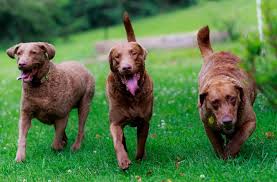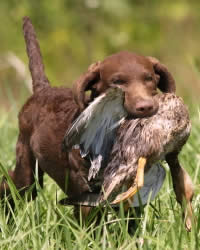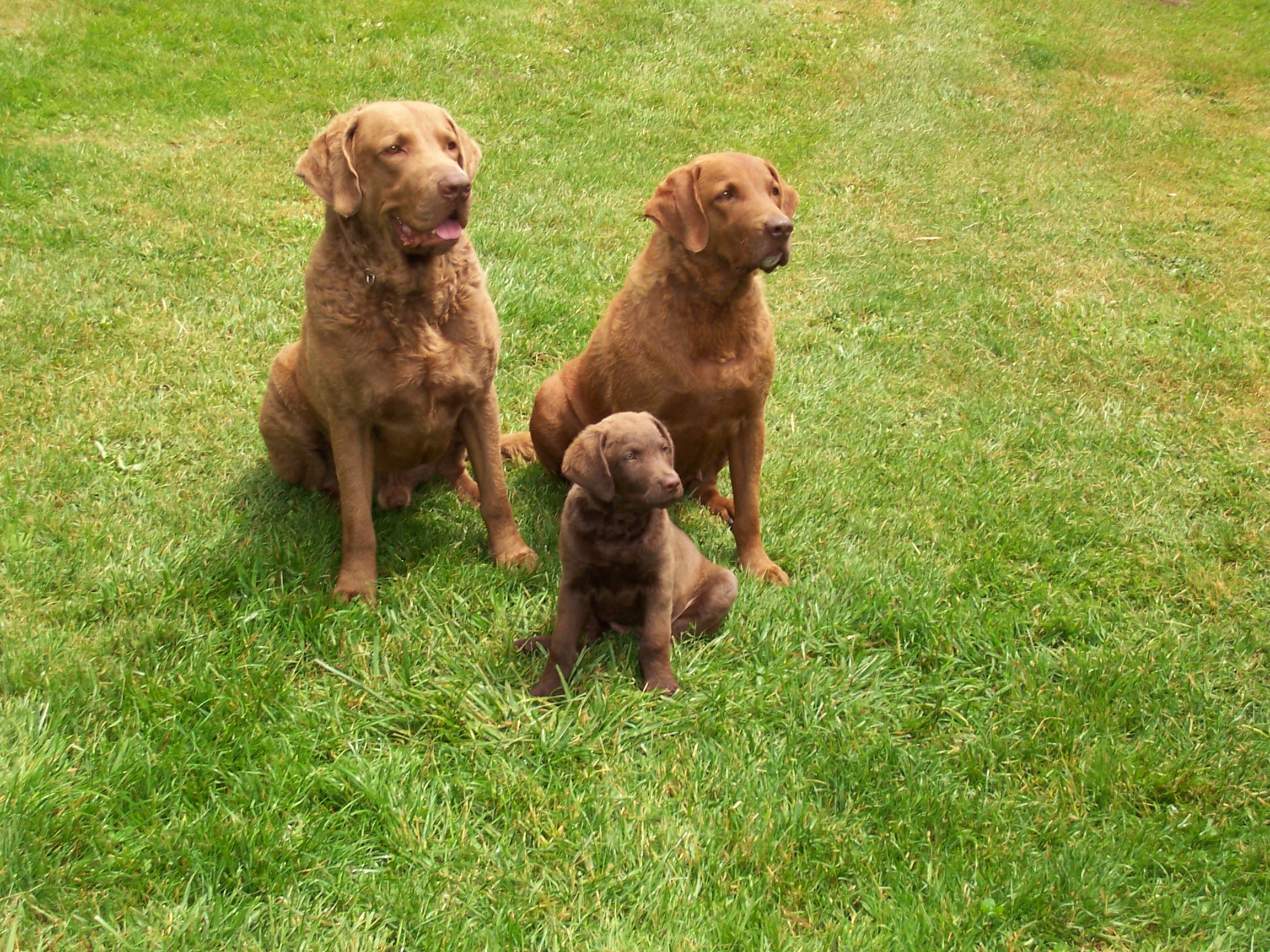 The Chesapeake Bay Retriever is a large, muscular dog that is sturdy and very solid looking even as a puppy. They come in various shades of brown ranging from a lighter tan or straw color through to a deep brown or mahogany color. The coat is rather short and may be somewhat wavy, especially down the back and around the neck and shoulder area. The Chesapeake Bay Retriever has a unique double coat that is slightly oily to the touch on both the inner and outer layers. This ensures that the dog can easily go in and out of the water even in very cold weather while only having minimum amounts of water stay in their coat. The tail is thick at the base and tapers to the end, usually carried slightly curled or flat.
The Chesapeake Bay Retriever is a large, muscular dog that is sturdy and very solid looking even as a puppy. They come in various shades of brown ranging from a lighter tan or straw color through to a deep brown or mahogany color. The coat is rather short and may be somewhat wavy, especially down the back and around the neck and shoulder area. The Chesapeake Bay Retriever has a unique double coat that is slightly oily to the touch on both the inner and outer layers. This ensures that the dog can easily go in and out of the water even in very cold weather while only having minimum amounts of water stay in their coat. The tail is thick at the base and tapers to the end, usually carried slightly curled or flat.
 |
THIS IS A PUPPY OF A CHESAPEAKE BAY
RETRIEVER |
The head of the Chesapeake Bay Retriever is broad and wide with a powerful and yet gentle looking slightly tapered muzzle. The shape of the skull is very round and the stop is not as pronounced giving a softer profile to the head than some breeds of retrievers. The hair on the head and face is much shorter than the hair on the rest of the body and the large round eyes are very visible. The eyes are yellow to amber in color and are particularly striking on the darker colored dogs. The ears are small in comparison to many of the hunting breeds and hang down just to the level of the mouth or lower jaw. They fold over completely and are not held erect.
 |
THEY ARE REALLY GOOD AT HUNTING
|
The neck is strong and muscular and blends nicely into the powerful front shoulders of the breed. The front legs and straight and well boned and muscled. The body is slightly longer than it is high at the withers, with a well-developed chest and ribcage
. The hind legs are very strong and powerful, easily able to propel the dog through water to allow them to run for long periods of time. The feet are webbed to enhance swimming ability.
 |
| THEY SEEM TO BE REALLY PLAYFUL DOGS. |
The coat is very dense, short and somewhat oily to the touch. Although the breed is double coated they are average shedders year round. The oils in the coat usually do not cause either an odor or management problem and the dogs should only be bathed occasional when necessary. The coat may be straight all over the body although wavy but not curly hair on the neck, chest and back is acceptable and very common.
 |
| THEY ARE GOOD SWIMMERS. |
t is believed that the Chesapeake Bay Retriever breed originated when a shipwreck occurred off the coast of Maryland in 1807. The story is that there were two Newfoundland dogs onboard that survived the shipwreck and these were given to a local family that was known as animal lovers
. The family then crossed the Newfoundland's with local retrievers and possibly native dogs which eventually led to the development of a very hardy breed that was able to swim in the cold waters in the Chesapeake Bay. Some breeders indicate that the Irish Water Spaniel
, bloodhound and other local mixed hound breeds may also form a part of the Chesapeake Bay Retriever's heritage. The Chesapeake Bay Retrievers
continued to be a popular dog in the area, and their amazing endurance and ability to tolerate even the coldest water temperatures with little concern earned them a place in duck and goose hunter's hearts. There are several claims by owners of the breed that they are capable of retrieving over a hundred ducks per day with some records of dogs bringing in up to 200 per day.
 |
| THEY ARE GOOD HUNTERS |
Currently the Chesapeake Bay Retriever is used as a watchdog, hunting dog, retriever, trial dog, obedience dog as well as a faithful family pet and companion dog
. The watchdog abilities are more pronounced in some lines than others and knowing the personality of the parents will really help in choosing a more or less protective puppy
. Their natural hunting and retrieving ability has also made them popular as a schutzhund breed. This demanding competition involves intelligence, agility and obedience as well as excellent communication between the handler and the dog.
 |
| THIS IS A PAINTING |
A Chesapeake Bay Retriever is an excellent family dog that is generally very good with children and other pets. It is important to properly socialize this breed as they are more dog-aggressive than other retrievers and can become territorial. They are good watchdogs and have a natural wariness with strangers however regular socialization and exposure to new people and new environments will help prevent this from becoming a problem. Unlike many of the hunting dog breeds the Chesapeake Bay Retriever tends to be much more independent and stubborn than the norm. They can be dominant and are known for their selective hearing of commands they simply wish to ignore. Not a mean spirited dog they just need consistent training and lots of positive praise for a job well done. The Chesapeake Bay Retriever is an excellent dog for obedience training at a young age to establish good behaviours and decrease the tendency for willfulness or independence.
 |
| THESE ARE 3 AND A HALF WEEK OLD PUPS |
The Chesapeake Bay Retriever is an intelligent dog
that learns best with repetition. They should always be trained using positive rewards and methods as their natural independence will only increase if negative training techniques are used. They are naturals at fetching and swimming and love exercise of all types in almost any kind of weather. They are not a hyperactive dog but do need regular, longer periods of exercise. In the house they are typically very relaxed and calm and will simply find a comfortable place to stay out of the way. They are not demanding of attention but love to be able to keep the family in sight.
 |
| THIS IS A FAMILY OF CHESAPEAKE BAY RETRIEVER. |
Overall the Chesapeake Bay Retriever
is a relatively healthy breed. They should not be exercised immediately after eating. The breed may also have problems with growth as puppies (OCD) and hip dysplasia
is a minor concern. Progressive Retinal Atrophy
and Entropion
are eye conditions that are seen in the breed.The natural independence and dominance of the breed makes it more difficult to train than other retrievers. Owners must positively and gently assert that they are the boss or this large dog will try to dominant the family. They also have an aloof presentation around strangers and should be introduced to lots of new people throughout their life to prevent them from becoming overly protective or possessive of their territory.
Although not recommended for first time dog owners the breed can easily be trained through use of a professional trainer
or obedience class provided the owners are willing to practice and follow through with the lessons.
 The Chesapeake Bay Retriever is a large, muscular dog that is sturdy and very solid looking even as a puppy. They come in various shades of brown ranging from a lighter tan or straw color through to a deep brown or mahogany color. The coat is rather short and may be somewhat wavy, especially down the back and around the neck and shoulder area. The Chesapeake Bay Retriever has a unique double coat that is slightly oily to the touch on both the inner and outer layers. This ensures that the dog can easily go in and out of the water even in very cold weather while only having minimum amounts of water stay in their coat. The tail is thick at the base and tapers to the end, usually carried slightly curled or flat.
The Chesapeake Bay Retriever is a large, muscular dog that is sturdy and very solid looking even as a puppy. They come in various shades of brown ranging from a lighter tan or straw color through to a deep brown or mahogany color. The coat is rather short and may be somewhat wavy, especially down the back and around the neck and shoulder area. The Chesapeake Bay Retriever has a unique double coat that is slightly oily to the touch on both the inner and outer layers. This ensures that the dog can easily go in and out of the water even in very cold weather while only having minimum amounts of water stay in their coat. The tail is thick at the base and tapers to the end, usually carried slightly curled or flat.





No comments:
Post a Comment